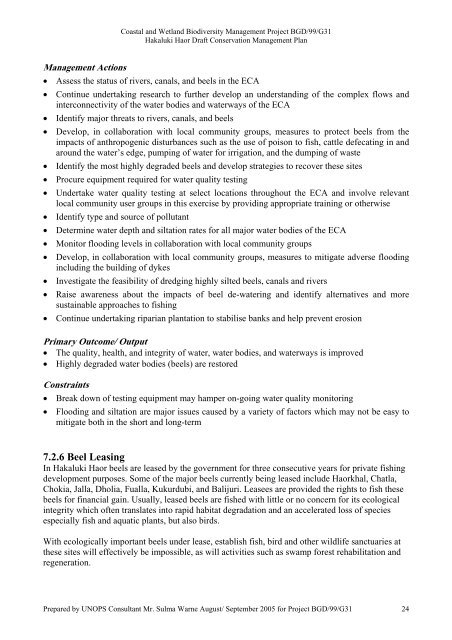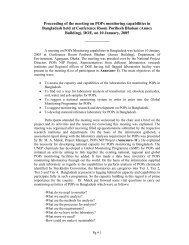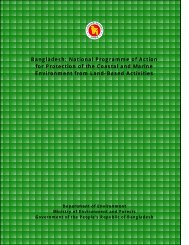Draft CMP HH - the Department of Environment
Draft CMP HH - the Department of Environment
Draft CMP HH - the Department of Environment
You also want an ePaper? Increase the reach of your titles
YUMPU automatically turns print PDFs into web optimized ePapers that Google loves.
Management Actions<br />
Coastal and Wetland Biodiversity Management Project BGD/99/G31<br />
Hakaluki Haor <strong>Draft</strong> Conservation Management Plan<br />
• Assess <strong>the</strong> status <strong>of</strong> rivers, canals, and beels in <strong>the</strong> ECA<br />
• Continue undertaking research to fur<strong>the</strong>r develop an understanding <strong>of</strong> <strong>the</strong> complex flows and<br />
interconnectivity <strong>of</strong> <strong>the</strong> water bodies and waterways <strong>of</strong> <strong>the</strong> ECA<br />
• Identify major threats to rivers, canals, and beels<br />
• Develop, in collaboration with local community groups, measures to protect beels from <strong>the</strong><br />
impacts <strong>of</strong> anthropogenic disturbances such as <strong>the</strong> use <strong>of</strong> poison to fish, cattle defecating in and<br />
around <strong>the</strong> water’s edge, pumping <strong>of</strong> water for irrigation, and <strong>the</strong> dumping <strong>of</strong> waste<br />
• Identify <strong>the</strong> most highly degraded beels and develop strategies to recover <strong>the</strong>se sites<br />
• Procure equipment required for water quality testing<br />
• Undertake water quality testing at select locations throughout <strong>the</strong> ECA and involve relevant<br />
local community user groups in this exercise by providing appropriate training or o<strong>the</strong>rwise<br />
• Identify type and source <strong>of</strong> pollutant<br />
• Determine water depth and siltation rates for all major water bodies <strong>of</strong> <strong>the</strong> ECA<br />
• Monitor flooding levels in collaboration with local community groups<br />
• Develop, in collaboration with local community groups, measures to mitigate adverse flooding<br />
including <strong>the</strong> building <strong>of</strong> dykes<br />
• Investigate <strong>the</strong> feasibility <strong>of</strong> dredging highly silted beels, canals and rivers<br />
• Raise awareness about <strong>the</strong> impacts <strong>of</strong> beel de-watering and identify alternatives and more<br />
sustainable approaches to fishing<br />
• Continue undertaking riparian plantation to stabilise banks and help prevent erosion<br />
Primary Outcome/ Output<br />
• The quality, health, and integrity <strong>of</strong> water, water bodies, and waterways is improved<br />
• Highly degraded water bodies (beels) are restored<br />
Constraints<br />
• Break down <strong>of</strong> testing equipment may hamper on-going water quality monitoring<br />
• Flooding and siltation are major issues caused by a variety <strong>of</strong> factors which may not be easy to<br />
mitigate both in <strong>the</strong> short and long-term<br />
7.2.6 Beel Leasing<br />
In Hakaluki Haor beels are leased by <strong>the</strong> government for three consecutive years for private fishing<br />
development purposes. Some <strong>of</strong> <strong>the</strong> major beels currently being leased include Haorkhal, Chatla,<br />
Chokia, Jalla, Dholia, Fualla, Kukurdubi, and Balijuri. Leasees are provided <strong>the</strong> rights to fish <strong>the</strong>se<br />
beels for financial gain. Usually, leased beels are fished with little or no concern for its ecological<br />
integrity which <strong>of</strong>ten translates into rapid habitat degradation and an accelerated loss <strong>of</strong> species<br />
especially fish and aquatic plants, but also birds.<br />
With ecologically important beels under lease, establish fish, bird and o<strong>the</strong>r wildlife sanctuaries at<br />
<strong>the</strong>se sites will effectively be impossible, as will activities such as swamp forest rehabilitation and<br />
regeneration.<br />
Prepared by UNOPS Consultant Mr. Sulma Warne August/ September 2005 for Project BGD/99/G31 24





